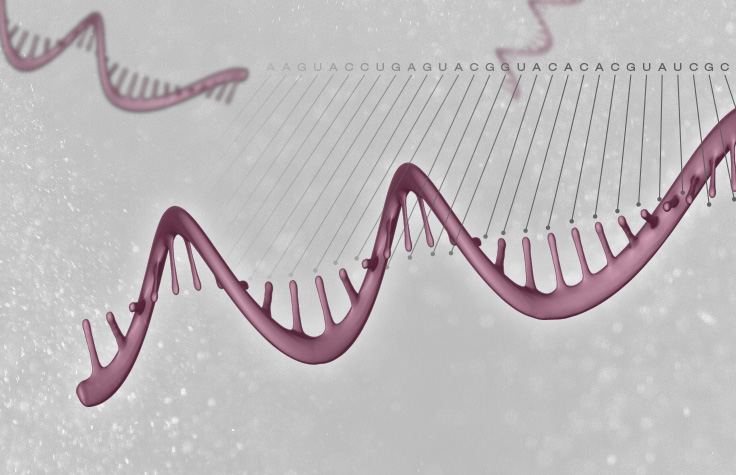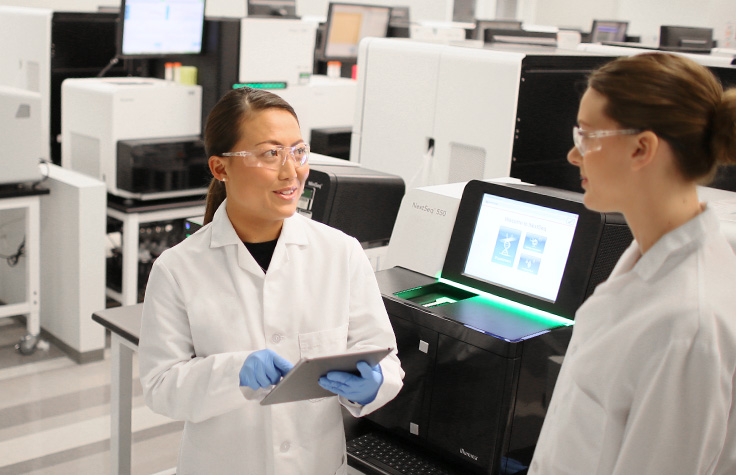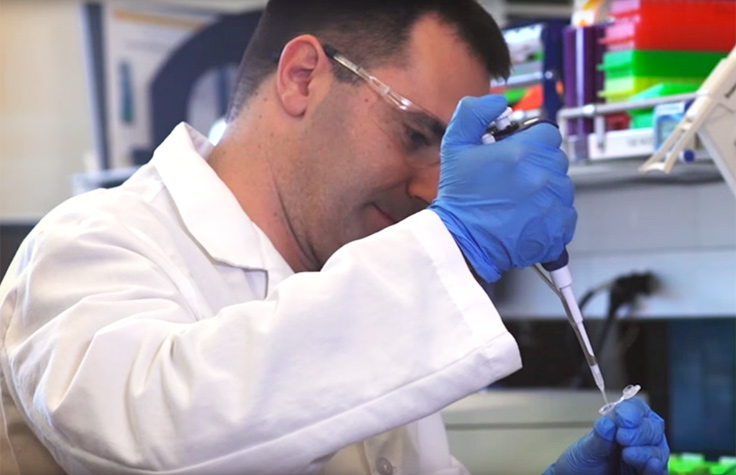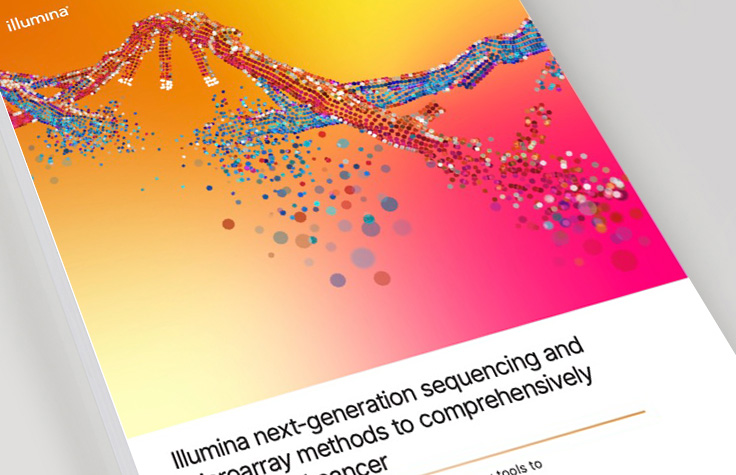Cancer RNA Sequencing

Understanding the Cancer Transcriptome
Monitoring gene expression and transcriptome changes with cancer RNA sequencing (RNA-Seq) can aid in understanding tumor classification and progression. Cancers accumulate numerous genetic changes, but typically only a few drive tumor progression. Cancer RNA-Seq can help scientists:
- Determine which variants are expressed in cancer samples
- Identify gene expression signatures and mutational profiles associated with individual tumors, single cells, and tumor types
- Focus on somatic mutations that have a clear functional effect, and identify key cancer driver mutations
- Find novel small RNAs that regulate gene expression
- Identify gene fusions arising from chromosomal translocations

Key benefits of cancer RNA sequencing
- Provides sensitive and accurate measurement of gene expression at the transcript level
- Provides both qualitative and quantitative data
- Sequences with high specificity and accuracy
- Maintains and tracks strand-specific information for both mRNA and total RNA workflows
- Provides excellent performance with degraded RNA from samples such as FFPE and tissue

Potential applications of RNA-seq in cancer research
Take advantage of bulk RNA-Seq with its exceptionally well-defined workflows backed by thousands of peer-reviewed scientific publications. Ease of use and the low cost of implementation make RNA-Seq an ideal method to obtain high-quality transcriptomic data for those new to NGS.
Learn more about NGS for beginnersRNA-Seq enables you to:
Differentiate driver mutations from passenger mutations
Although cancer cells contain many mutations, only a few contribute to cancer initiation and progression. Researchers can use bulk RNA-Seq to examine the complete set of RNA transcripts produced by a genome. Data from the RNA-Seq experiment can reveal whether mutations result in transcriptomic changes that either drive cancer or act as passenger mutations.
Identify potentially druggable pathways
RNA-Seq can reveal pathways that are up- or down-regulated in cancer. This functional information is crucial for identification of molecular targets for precision therapeutics. Targeting upregulated pathways, for example, is a common method for suppressing tumor growth.
Discover pathways associated with disease
Studies into the transcriptomic differences between cancer samples and non-cancerous tissue have been shown to be useful in differentiating cancer subtypes, assessing the impact of mutations, identifying biomarkers, and other variables.
Assess biological responses
Bulk RNA-Seq can identify genes and pathways associated with biological responses to novel cancer therapies, such as immunotherapeutics in model systems or retrospective studies using past tissue samples.

Featured cancer RNA-Seq methods
Bulk RNA-Seq
RNA-Seq allows researchers to detect known and novel features in a single assay, enabling the identification of transcript isoforms, gene fusions, single nucleotide variants, and other features without the limitation of prior knowledge.
Single-cell RNA-Seq
Learn more about single-cell RNA sequencing to examine the transcriptomes of individual cells for a high-resolution view of cell-to-cell variation.
mRNA-Seq
See how mRNA-Seq can identify both known and novel transcript isoforms, gene fusions, and other features, as well as allele-specific expression for a complete view of the coding transcriptome.
Total RNA-Seq
Learn how total RNA-Seq can accurately measure gene and transcript abundance and identify known and novel transcriptome features.
CITE-Seq
Explore the unique advantages of this method that simultaneously quantifies cell surface protein and transcriptomic data within a single cell readout.
Spatial transcriptomics
Explore how this method can provide a topographical arrangement of gene expression patterns mapped onto tissue sections to link structure and activity.

Cancer Research Methods Guide
The Cancer Research Methods Guide is a 40+ page comprehensive resource with simple, comprehensive workflows for a broad range of cancer research applications. This guide includes single-cell sequencing, spatial sequencing, methylation profiling, multiomics, cell-free RNA sequencing, and more.
Download free guideCancer RNA sequencing workflow
Library prep
Illumina Stranded mRNA Prep
A high-performance, fast, and complete whole-exome sequencing kit including library prep and hybridization reagents, a comprehensive exome probe panel, clean up/size selection beads, and indexes.
Illumina Stranded Total RNA Prep w/ Ribo-Zero Plus
Illumina Total RNA Prep with Ribo-Zero Plus provides exceptional performance for the analysis of coding and multiple forms of noncoding RNA.
Illumina RNA Prep for Enrichment
Illumina RNA Prep with Enrichment uses on-bead tagmentation technology followed by simplified, single hybridization to provide an exceptionally fast workflow for RNA-based library prep and enrichment.
Sequencing or arrays
NextSeq 1000 and 2000 Systems
These cost-efficient, user-friendly, mid-throughput benchtop sequencers offer extreme flexibility to support new and emerging applications.
NovaSeq X Series
The NovaSeq X Series offers vast application breadth, enabling data-intensive methods at production scale.
Data analysis
DRAGEN RNA and DRAGEN RNA Differential Expression Apps
Accurate, comprehensive, and efficient analysis of NGS data, including alignment, quantification, fusion detection, and differential gene expression analysis.
Correlation Engine (for mRNA)
Correlation Engine is an interactive omics knowledgebase that puts private omics data in biological context with highly curated public data.
Keep exploring
An easier workflow for identifying RNA fusion events for cancer research
Learn how cancer researchers can use Illumina RNA Prep with Enrichment and Trusight panels to get focused results for cancer-related gene expression and fusion detection.
Deciphering the role of long non-coding RNA in cancer
Researchers are using RNA-Seq to reveal how lncRNAs could be used to identify, measure, and treat cancer.
Targeted RNA-Seq
Targeted RNA sequencing analyzes the expression of specific cancer genes and transcripts of interest.
Genomics and transcriptomics basics
Download the infographic to learn the basics of genome and transcriptome sequencing at a glance.
Sequencing DNA and RNA from the same sample
Watch the new in-lab quick start video to learn how to prepare high quality DNA and RNA samples for multiomic sequencing.
Advancing cancer research with multiomics
Learn how to link the causes and consequences of complex phenotypes through multiomics to enable discoveries that weren’t possible before.